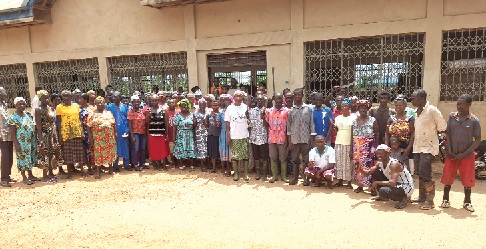Cocoa farmers and residents in communities within the country’s cocoa forest landscape have spoken highly about the transformation the Ghana Cocoa Forest REDD+ Programme (GCFRP) has made in their lives.
The GCFRP is an emission reduction programme that was implemented across the country’s cocoa forest landscape in 2019 as an incentive for small-holder farmers to adopt sound agronomic practices for climate resilience.
The three-pronged objectives of the programme were to reduce expansionist cocoa production activities in forest areas; cut down emissions by about 40 per cent within the 20-year lifespan of the strategy (2016-2035), and improve the livelihoods of cocoa farmers.
After five years of implementing the programme, the 560,808 small-holder farmers within the cocoa forest landscape have adopted sound agronomic practices that led to improved crop yields while also reducing carbon emissions to build climate resilience.
Additionally, residents in the six hotspot intervention areas (HIAs) across the Eastern, Ashanti, Western, Western-North, Central and other cocoa-growing regions have also benefitted from community projects undertaken with funds from the $21.8 million carbon payments received from the World Bank.
Field trip
During a field trip by a monitoring team from the REDD+ Secretariat at the Forestry Commission and the Global Landscape Forum (GLF) recently, it came to light that GCFRP had become a saviour for the farmers and community members.
The delegation undertook a three-day trip to the Atewa HIA and some natural climate change intervention sites in the Northern Region.
During the trip, it came to light that between 2019 and 2021, the emission reduction programme implemented across the country’s cocoa forest landscape has attracted about $21.8 million in carbon payments, which have been disbursed as an incentive for small-holder farmers to adopt sound agronomic practices for climate resilience.
Also, figures shared with the Daily Graphic showed that there was an outstanding payment of $29 million covering benefits for carbon reduction from 2022 to 2024.
Communities
At the Atewa HIA, where 21,099 farmers, comprising 12,407 male and 8,652 female, are benefitting from the programme, the team visited cocoa farms and alternative livelihood sites in communities such as Kyebi-Potroase and Wirenkyren Amanfrom in the Abuakwa South municipality to learn at first hand the impact of the REDD+ programme.
The delegation, which also included a team from the Daily Graphic, observed that the intervention had left giant footprints in the community and transformed the lives of farmers, ensuring sustainable farming.
Positive impacts
The Chairman of the Atewa HIA, Collins Akonnor, said the carbon payment that had been received so far had been used for the implementation of some community projects and procurement of inputs for climate action.
He explained that 58 per cent of Atewa HIA’s share of the funds went into the procurement of machetes, Wellington Boots, motorised mixed blowers and tree seedlings to support farmers.
Mr Akonnor said the managers of the Atewa HIA had procured about 60,000 tree seedlings and shared to farmers in the area.
He said the remaining 39 per cent of the allocation for the Atewa HIA had been used for community projects such as the construction of boreholes, health facilities and other projects that were necessary for the people.
“The funds have really benefitted farmers. Initially, our understanding of the environment was very low, so we engaged in bad farming practices that affected the forest.
“However, through this programme, they have built our capacity on climate change, how our activities affect the climate, and how we can do sustainable farming,” he added.

